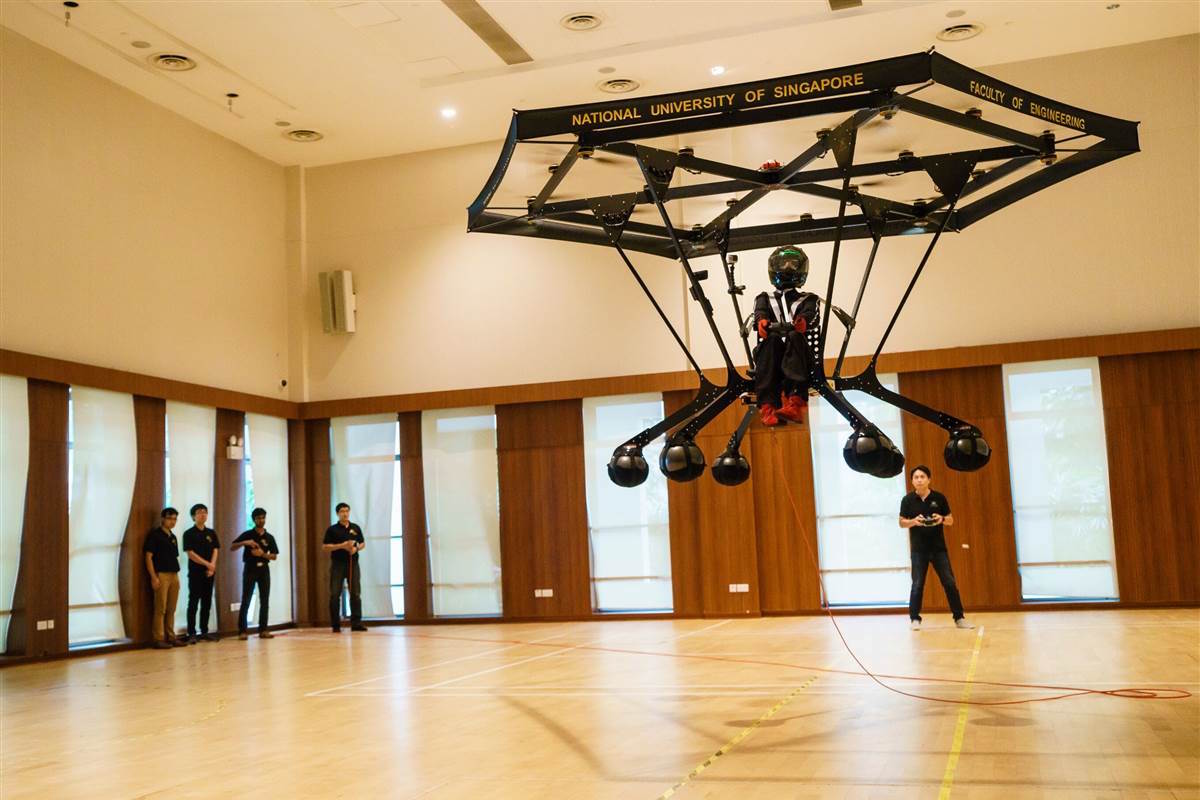Tag Archives: NUS
EsoGlove Robotic Wearable Restores Hand Movements

A team of researchers from the National University of Singapore has developed a robotic glove that can help with hand rehabilitation after nerve-damaging injuries or strokes.
Injuries, nerve-related conditions and strokes can cause people to lose motor skills, and hands are most frequently affected. The NUS research team comprised of Asst Prof Yeow, his clinical collaborator Dr Lim Jeong Hoon from the NUS Department of Medicine, as well as PhD candidate Mr Yap Hong Kai and undergraduate student Mr Benjamin Ang Wee Keong, who are both from the NUS Department of Biomedical Engineering, has developed a robotic glove they named EsoGlove in an attempt to restore hand movements in these patients.
“For patients to restore their hand functions, they need to go through rehabilitation programmes that involve repetitive tasks such as gripping and releasing objects,” explained Assistant Professor Raye Yeow from the NUS Department of Biomedical Engineering, a specialist in soft wearable robotics and a key member of the research team. “These exercises are often labour intensive and are confined to clinical settings. EsoGlove is designed to enable patients to carry out rehabilitation exercises in various settings – in the hospital wards, rehabilitation centres and even at home. Equipped with technology that can detect and interpret muscle signals, EsoGlove can also assist patients in daily activities, for instance by guiding the fingers to perform tasks such as holding a cup.”
The robotic glove represents a step forward from the conventional hand rehabilitation devices, which have rigid electromechanical components, since its sensors are able to pick up muscle signals and the it is able to follow the natural movements of the human hand, thus diminishing both injury risks and discomfort. On top of that, EsoGlove is also very portable thanks to its very compact design.
“EsoGlove is unique as it is made entirely of soft components and does not require complicated mechanical setups. The main body of the glove is made of fabric, with soft actuators embedded. It also has adjustable Velcro straps to cater to different hand sizes,” Asst Prof Yeow said.
“With this unique approach, we can develop therapeutic tools using safe and wearable robotic technology. Patients can take the initiative in their own rehabilitative process, rather than being passive recipients of therapists’ intervention,” added Dr Lim, a Senior Consultant at the National University Hospital’s Division of Neurology.
Mr Yap, who is also from the NUS Graduate School for Integrative Sciences and Engineering, explained how exactly the EsoGlove is supposed to work: “As the soft actuators in the EsoGlove are made from non-ferromagnetic materials, they are suitable for use in functional magnetic resonance imaging studies. We hope that the robotic glove can contribute towards investigating the brain’s activity in relation to motor performance during hand rehabilitation, and unravel the functional effects of soft rehabilitation robotics on brain stimulation.”.
EsoGlove is patent-pending device, and once that is obtained, the team will start a spin-off company to sell the product.
Be social! Follow Walyou on Facebook and Twitter, and read more related stories about the robotic glove that helps stroke patients regain motor skills, or the Goldfinger smart glove that is powered by finger movements.
‘Snowstorm’ personal flying machine lifts off in Singapore
 What you're looking at above is Snowstorm, a personal flying machine. This electric-powered aircraft, designed and built by a group of students from the National University of Singapore, can be controlled by a human pilot and is capable of a vertical...
What you're looking at above is Snowstorm, a personal flying machine. This electric-powered aircraft, designed and built by a group of students from the National University of Singapore, can be controlled by a human pilot and is capable of a vertical...
Artificial muscles lift 80 times their weight, pave the way for robot Superman
Other than a few models from Boston Dynamics, most robots don't exactly leave us quaking in fear. That might be off the table soon, though, thanks to a breakthrough from researchers at the National University of Singapore (NUS). They've developed polymer-derived artificial muscles that can stretch out up to five times in length, enabling them to lift 80 times their weight. That could one day result in life-like robots with "superhuman strength and ability," which could also run on very little power, according to the team. They expect to have a robotic limb that could smack down any human in arm-wrestling within five years -- putting a possible cyborg version of Over The Top alarmingly within reach.
Spotify offering students in the UK a 50 percent discount on Premium service
Streaming outfit Spotify and the National Union of Students have teamed up to offer scholars in the UK a whopping 50 percent discount on the music service's Premium plan. Of course, you'll have to meet a few requirements first, including having an "extra" NUS card and, naturally, a Spotify account. Once you've got those credentials in place, Spotify's Premium service will only set you back £4.99 per month, which gets you an all-you-can-stream buffet on both desktop and mobile -- yes, that includes the shiny new iPad app. The deal's said to be good for 12 months from the moment you sign up, and you can get started now at the NUS link below.
Continue reading Spotify offering students in the UK a 50 percent discount on Premium service
Spotify offering students in the UK a 50 percent discount on Premium service originally appeared on Engadget on Thu, 03 May 2012 13:16:00 EDT. Please see our terms for use of feeds.
Permalink Tech Digest |
Tech Digest |  NUS | Email this | Comments
NUS | Email this | Comments 
